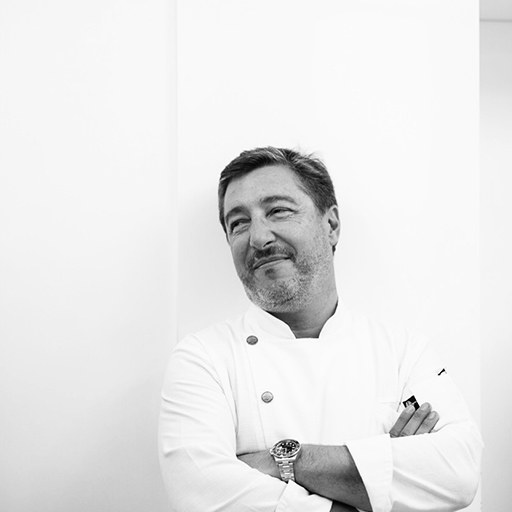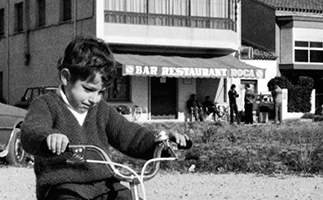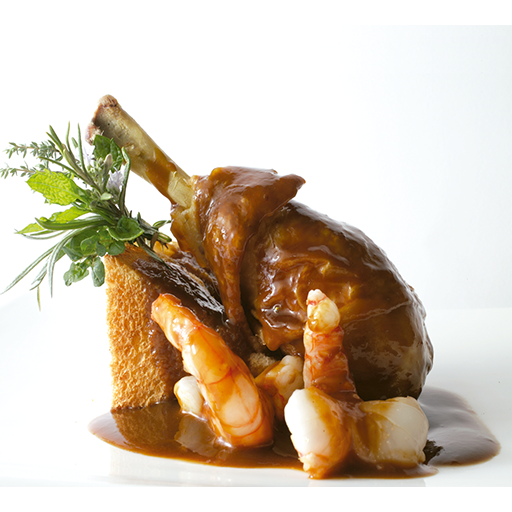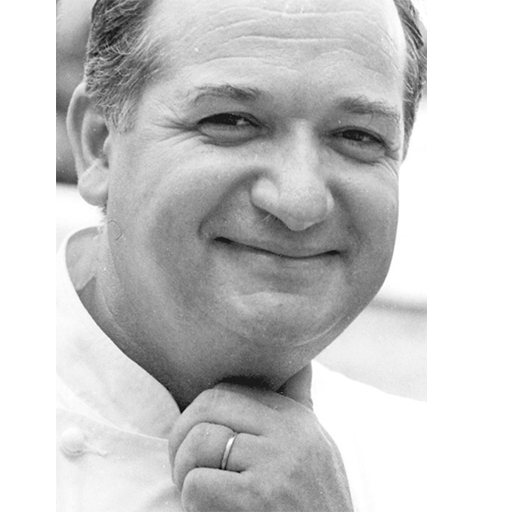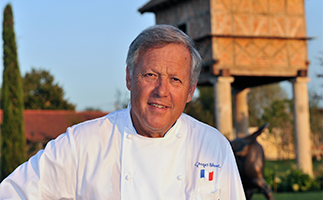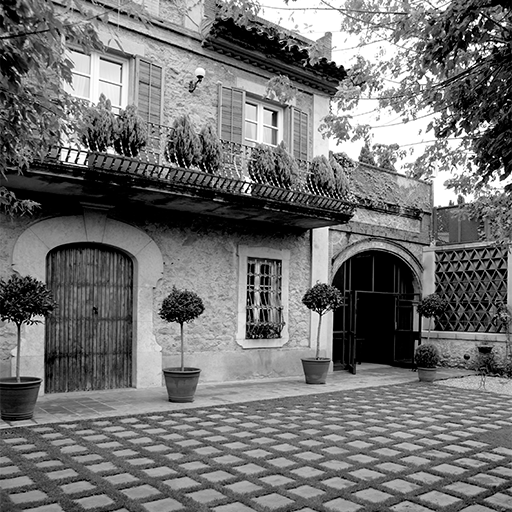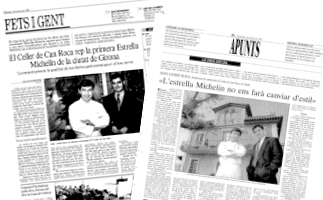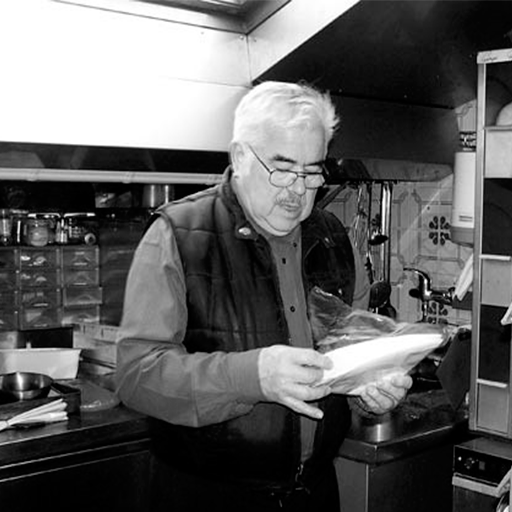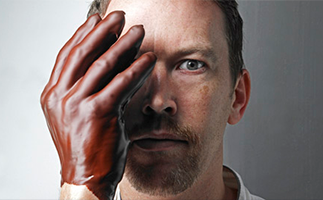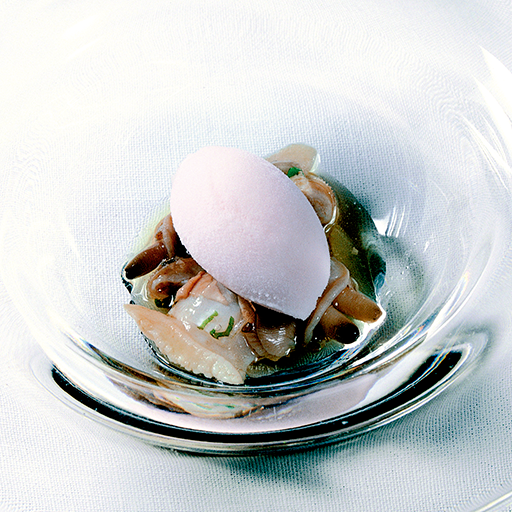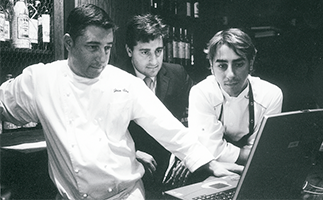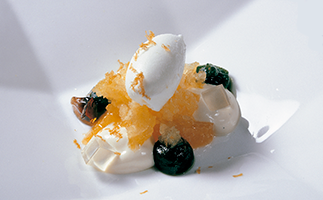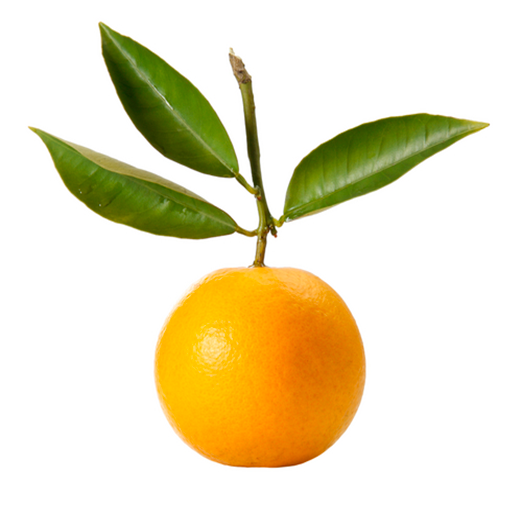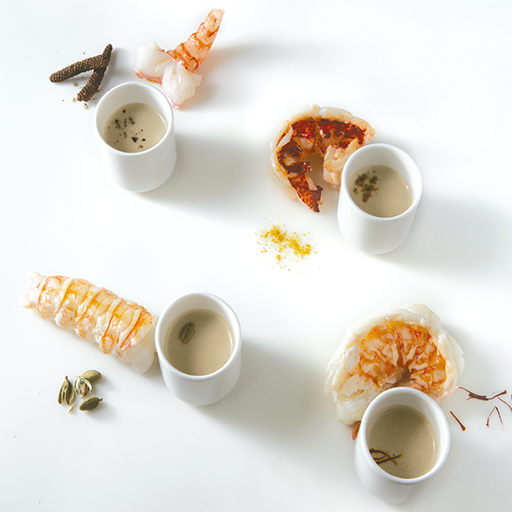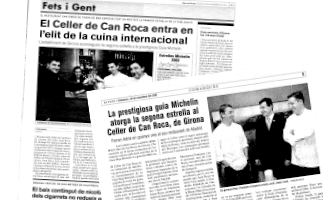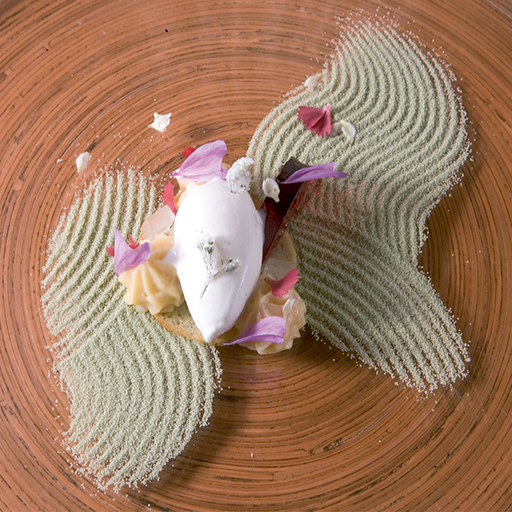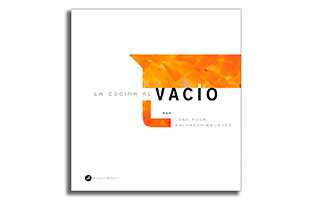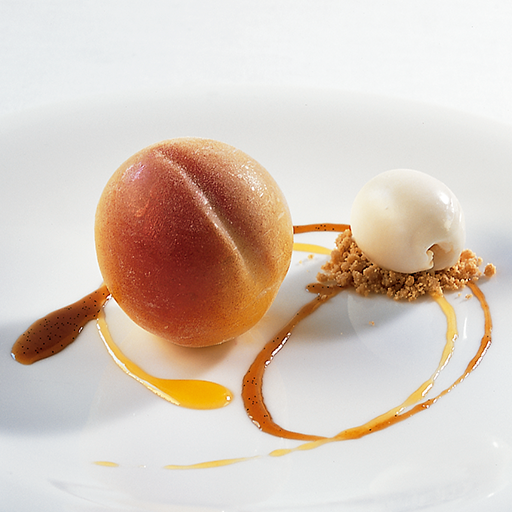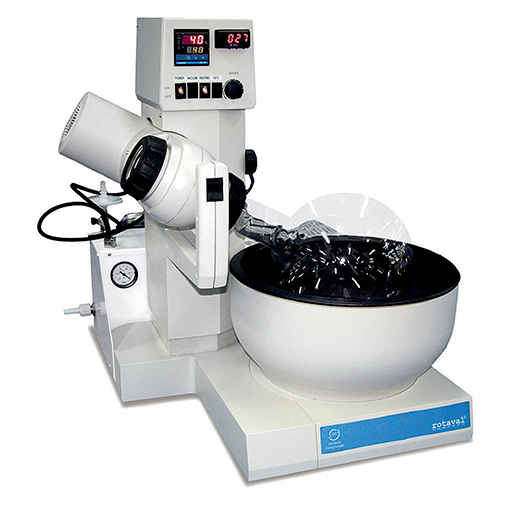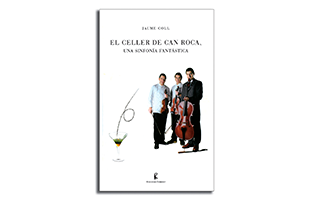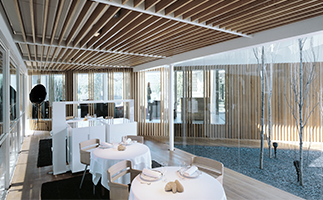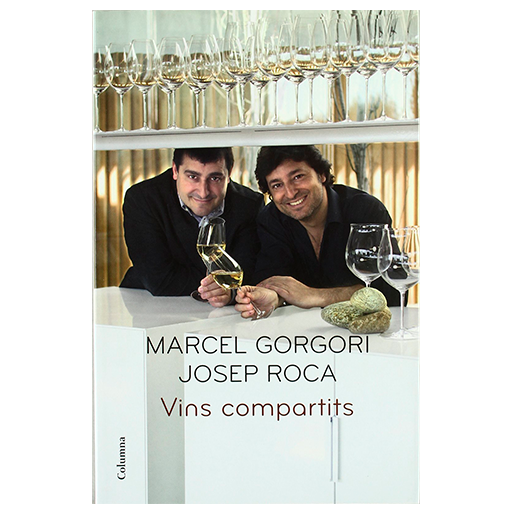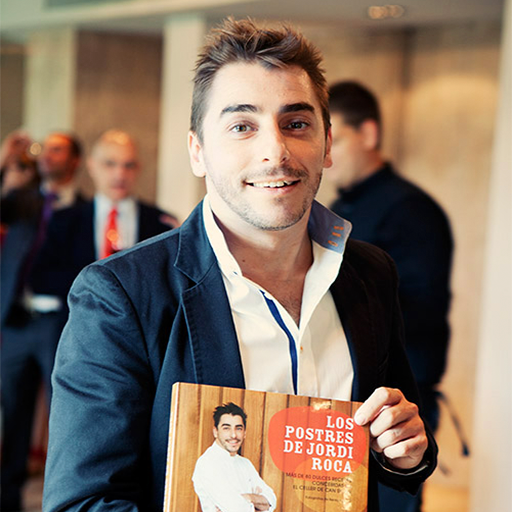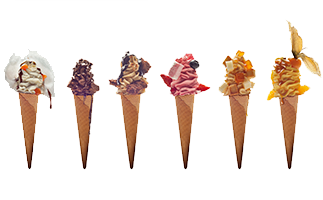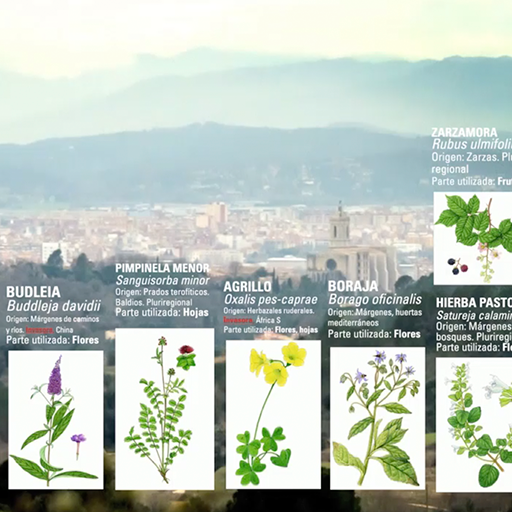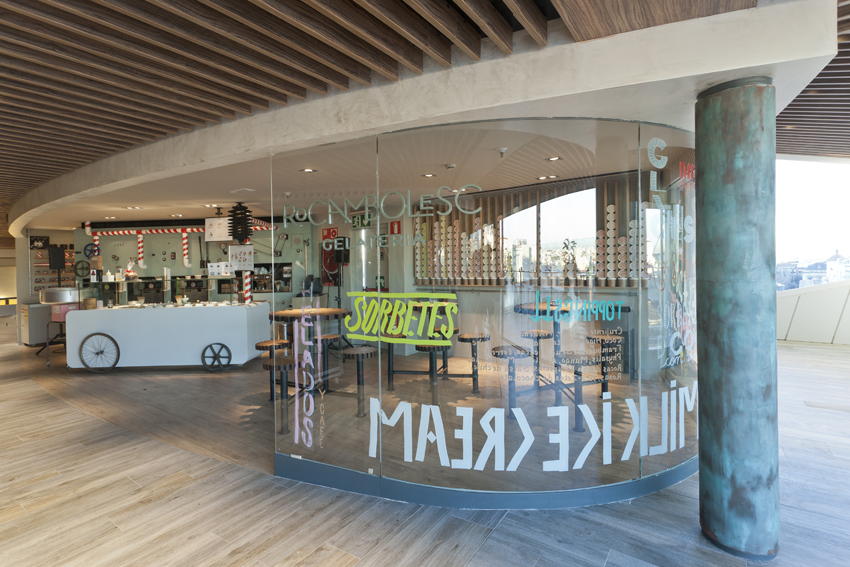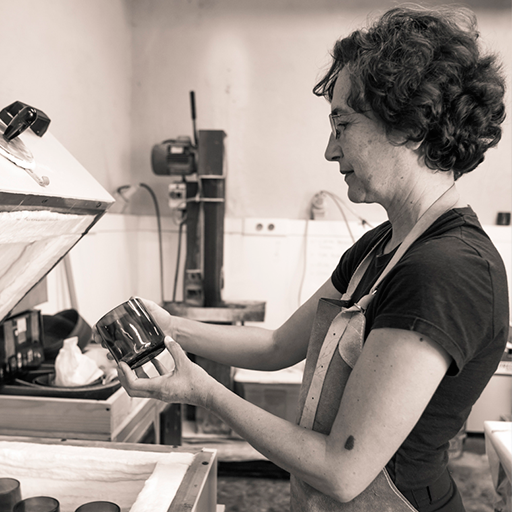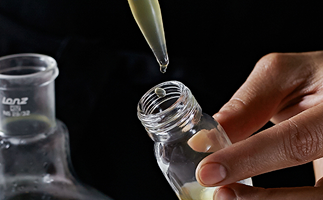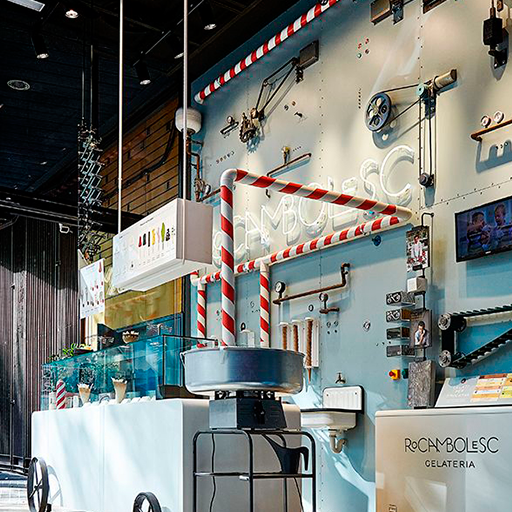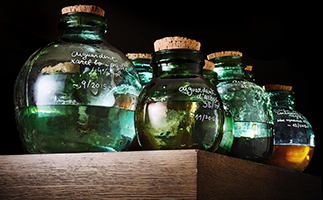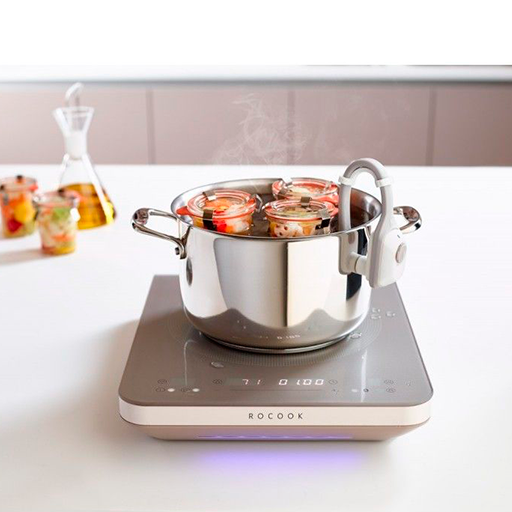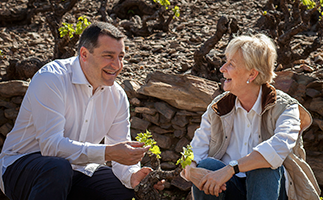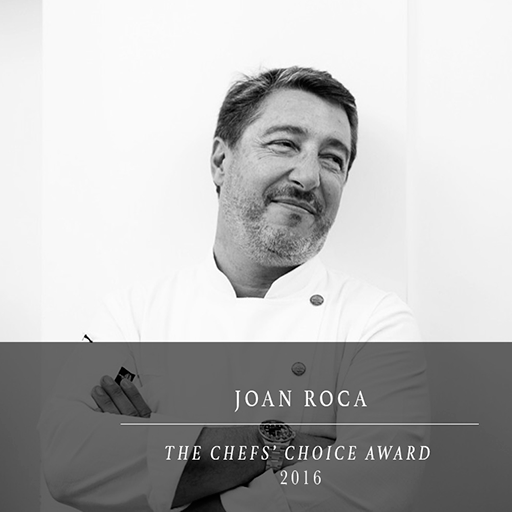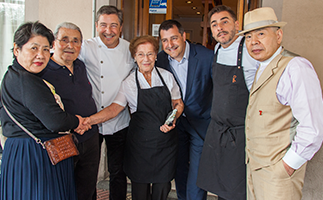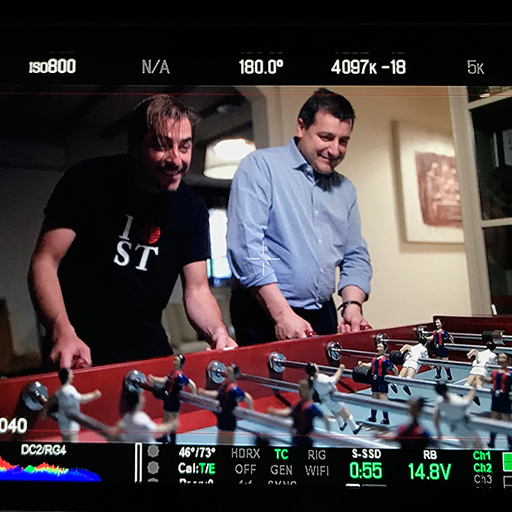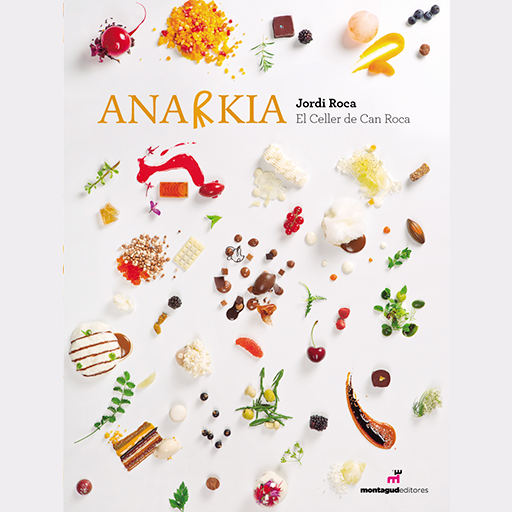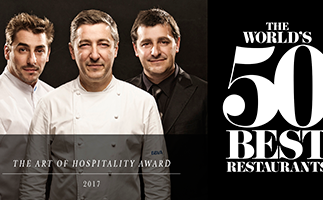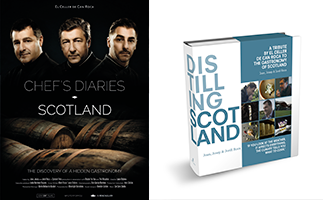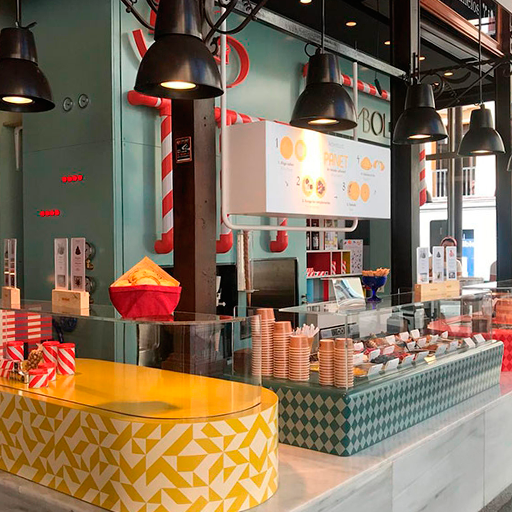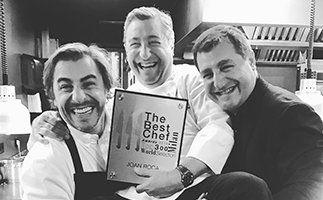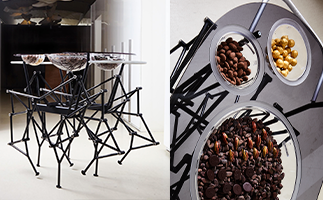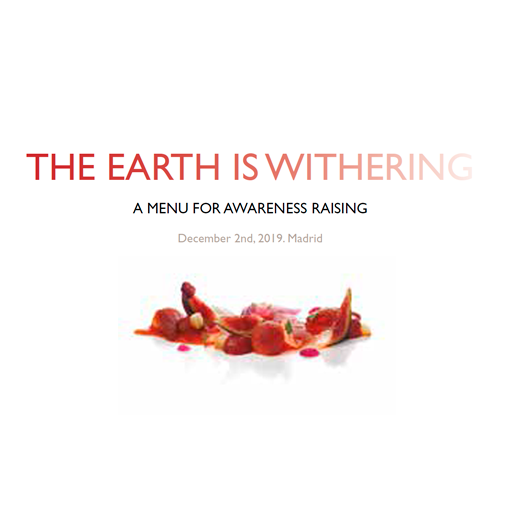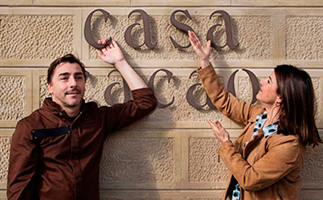El Celler de Can Roca.
Carrer de Can Sunyer, 48
17007 Girona
Tel. 972 222 157
info@cellercanroca.com
It is also the timeline of the maturation of a cooking style, and of a concept of hospitality, born from the family roots to evolve through a strong commitment into creative freedom and innovation, while honoring the memory of tradition and academicism, as well as small farmers and their land.
Joan Roca i Fontané, son of Josep Roca, bus driver, and of Montserrat Fontané, cook at the Lloret restaurant in Girona, was born in February.
The Girona Catering School, led by Vicenç Andreu, was created. This school was to prove crucial in the Roca family’s culinary history.
Josep Roca i Fontané was born in March
In April, Josep Roca and Montserrat Fontané opened Can Roca, a bar- restaurant in Taialà-Germans Sàbat, a popular neighbourhood on the outskirts of Girona.
Jordi Roca i Fontané, the youngest of the three Roca brothers, was born in May.
Joan and Josep Roca opened El Celler de Can Roca in August, on premises next to Can Roca, their parents’ bar.
El Celler’s first dish: Hake with rosemary and garlic vinaigrette, fruit of Joan’s contact with Basque cuisine, particularly at Ramon Roteta’s restaurant.
Chicken legs with prawns, a “surf and turf” that comprises elements of Can Roca’s traditional cuisine and the more academic technical cuisine.
One of the restaurant’s longest-standing dishes: Lobster parmentier with black trumpets. A dish which is still on the menu, as a testimonial to the clients that remained faithful to El Celler over its twenty-five years of history.
Joan spends a season in El Bulli, where Ferran Adrià was looking for a new way, which with the passage of time would turn him into one of the biggest cooks of our time.
The previous year had known Santi Santamaria, in Can Fabes, the Joan’s first contact with a cook of height.
Another classic: Pigs trotter carpaccio with penny bun (boletus edulis) oil. A dish that is part of the chef’s professional memory. Quality of imagination and taste. Joan Roca says it is the first dish that he was truly happy with.
Joan and Josep visit the Pic restaurant in Valence. The atmosphere of the quest for happiness that was created there, and the image of Jacques Pic reflected in the set of copper pats and pans hanging from the hood when they went in to greet him dazzled them. The day they decided to dedicate their lives to haute cuisine.
Joan had a spell with Georges Blanc, in Vonnas, where he discovered the applications of sous-vide (vacuum) in a kitchen. As of then Joan began to experiment with exact temperature control and the duration of cooking.
They opened La Torre de Can Roca, a space for banquets, a mere hundred metres from the restaurant, and which gradually became what is now known as El Celler de Can Roca.
The Michelin guide awarded the Roca brothers the first star to a restaurant of the city of Girona.
Joan invited Georges Pralus, author of “La cousine sous vide”, 1985, a forerunner in the use of vacuum cooking in restaurants, to the Catering School.
Joan and his colleague from the School, Salvador Brugués, investigated the technique based on the idea of low-temperature cooking, also influenced by the experiments of Hervé This.
At that time there was a certain influence of classic French cuisine, particularly in the use of products or treatments: foie gras, magrets, terrines, vinaigrettes, royales or veloutés.
One example of this is one of the core dishes of El Celler: Timbale of apple and duck liver with vanilla oil. A Roca brothers historic dish which, years later, in 2009, they donated to the city of Girona at the Local Festivities.
Together with another schoolmate, Narcís Caner, they developed the roner, which allows you to control water in order to cook with the utmost precision.
They started to use the immediate cooking technique, which is instant vacuum cooking, i.e. during the service. Vacuum had only been used previously for pre‑cooking or for preservation; times are now longer and cooking temperatures diminish.
The first course Cod with spinach, raisins and pine kernels dates from 1997.
The dessert trolley was dispensed with at a time when the restaurant was being refurbished and extended.
It heralds a turning point in the sweet cuisine of El Celler, reinforced by the arrival of a Welsh dessert chef, Damian Allsop, and also when Jordi Roca joined as his assistant.
El Celler entered an author’s cuisine phase, where creativity took on two trends: one based on a reinterpretation of traditional dishes and products. One example is the reinterpretation of the family habit of going out for the Sunday “vermouth”: Clam with grapefruit sorbet and Campari.
Pau Arenós published Els genis del foc (Geniuses of the range) (Empúries), portraying 10 Catalan avant-garde chefs. This books aspired to being a founding manifesto of a new way of understanding cooking. Joan Roca is one of the ten, whose cuisine is defined as “highly evolved, which has flourished with splendour from traditional roots, erected on the steadfast foundations of the family”.
The other trend is based on the process of conceiving and creating a dish without evident references: Caviar omelette.
Blending the salt of the sea with the sweetness of the earth; caviar with hens’ eggs, in a dish full of technical solutions.
Jordi Roca took over the restaurant’s sweet cooking definitively. The three brothers had found their place: the salt mind (Joan), the liquid mind (Josep) and the sweet mind (Jordi).
Another one of the dishes that will remain on the restaurant’s menu for some time to come, and which has been continually reinterpreted: Iberian suckling pig with pepper sauce and garlic and quince terrine. The maximum expression of the low-temperature vacuum cooking technique.
Addition of smoke into fatty molecules. On the Journey to Havana they managed to retain the smoke of a Havana cigar in the mouth.
It is one of the first great dishes of Jordi Roca‘s cuisine, who this same year was brought into the world of ice-cream, with the help of Angelo Corvito.
Wine emerged from the confines of the dining room and began to play an important role in the kitchen as well. Wine as a point of departure in the creative process of a dish. Texturised wine became part of the dish. This is the concept of wine cooking, represented by Anchovies, truffle and Merlot.
The first Adaptation of the Eternity fragrance by Calvin Klein opened up a series of dishes based on a concept at that time unknown in cooking: capturing the volatile soul of a perfume, deciphering the formula and adapting it to an edible reality
Bergamot makes its appearance in El Celler’s cuisine. This citrus would subsequently enjoy particular importance in the Roca brothers’ cuisine: it became the point of departure for the scented desserts.
A new technique represented by Dublin Bay prawns with curry smoke: perfume cooking, consisting of setting the volatile aromas of the spices being roasted in the product during cooking.
Second star in the Michelin guide.
The observation of the landscape as a point of departure for the creation of a dish became a new concept: the garden series was born. The Mediterranean garden or this Zen garden are examples of this.
Sous‑vide cuisine, by Joan Roca and Salvador Brugués (Montagud) was published and translated into Spanish, French, English and Italian.
It is a reference point in the world and laid the foundations for a highly valuable cooking technique, fundamental in the evolution of cooking in the future.
They began to use a technique thitherto used solely for decorative purposes: blown sugar applied to immediate cooking.
Caramelised apricot is an example of when cooking becomes an art of simulations, insinuations, appearances.
A new series of creations based on a new concept began: monochromatisms. The chromatic part of the ingredients are related to their taste aspect and the sensation produced: energetic, refreshing, vital, euphoric: Green chromology
Jordi Roca’s dish: Anarchy.
The pleasure of the random tasting of a thousand and one flavours. 43 tiny elements on one dish: 12 creams, 7 gelatines, 7 sauces, 3 granitas, 2 foams, 2 ice‑creams, 3 fruit cakes, 7 crunches.
In the making of Baby octopus in Pimentón de la Vera paprika smoke, a mechanical tube was used for the first time ever to control the smoke.
The objective was to bring the smoke to the table and provoke affective sensations appealing to the olfactory memory
The inclusion of distillates in cooking. Volatile aromas were captured by means of low temperature distillation. The Rotaval was developed jointly with the Fundació Alicia.
This technique gave rise to a first course that was to become an El Celler flagship: Oyster with earth distillate
The book Joan Roca: la cuina de la meva mare (Joan Roca: my mother’s cooking) (Columna), was published, a compilation of one hundred and twenty Can Roca traditional recipes in homage to Montserrat Fontané’s traditional Catalan cooking and which lay the foundations for their own cuisine.
Oyster with cava was the culmination of a long research drive to accomplish the texturisation of cava, preserving its endogenous carbonic acid gas. Cava thus became a sauce, without impairing its organoleptic properties.
The Sòlid, a cava with density, was marketed jointly with Agustí Torelló Mata.
The book El Celler de Can Roca, una simfonia fantàstica (El Celler de Can Roca, a fantastic symphony), by Jaume Coll (Edicions Domeny), was published. The book detailed the restaurant’s evolution over its first twenty years, step by step and person by person.
It was published in Catalan, Spanish, French and English
The cuisine at El Celler de Can Roca was becoming increasingly more about moods. Research into how to impact moods through dishes led to the Milk dessert.
The restaurant relocated from its initial location next to Can Roca to the old Torre de Can Roca. The former 170 square metre premises were quadrupled on new and more comfortable premises: 200 square metres of kitchen, 200 of winery, 200 of dining room and 60 for the hall, plus a welcoming garden.
Jordi Roca published Dolces sensacions (Sweet Sensations) (Ara llibres), a compilation of sweet cooking recipes he created especially for the Cuina magazine.
Joan Roca, deu menús per a un concert (Galerada), un recull de deu àpats pensats a partir de deu fragments musicals d’òpera i música clàssica.
Mediterranean garden symbolised another work of science and gastronomy: the extraction of essential oils to apply them to cooking.
El Celler de Can Roca was awarded its third Michelin star.
Vins compartits (Shared Wines), by Marcel Gorgori and Josep Roca (Columna), was published. It is a compilation of a series of commented wine tastings based on the friendship between the journalist Marcel Gorgori and the El Celler sommelier, as a result of their participation in the En clau de vi television programme (C33).
The Soft escalivada heralded the inclusion of smoke straight from the embers onto the dish.
A new technique: cooking wine in the living room.
Immediate cooking is now sought by means of wines that are converted into steam in front of the diner, so that they cook and perfume the product with volatile aromas. Chamomile oysters are an example.
The British Restaurant magazine placed El Celler de Can Roca second in the list of The World’s 50 Best Restaurants. In 2009 it was fifth, and fourth in 2010. In 2012 remains the second.
The book Los postres de Jordi Roca (Jordi Roca’s desserts) (Oceano Ambar) was published, a compilation of 80 dessert recipes, with photographs by Becky Lawton, which were part of his monthly collaboration with the Cuina magazine.
The Rocambolesc ice‑cream parlour was opened in the centre of Girona. It sells artisanal, totally natural ice-creams, plus El Celler desserts to take away.
The dessert trolley returned to the dining room of El Celler de Can Roca, fruit of the collaboration with the industrial designer Andreu Carulla.
Joan Roca receives the Grand Prix de l’Art de la Cuisine by the International Academy of Gastronomy (AIG).
The La Masia (I+R) embryo is born, welcoming artists and farmers of the gastro-opera El Somni to our restaurant. 1 year of pure creative transversality and exchange between El Celler de Can Roca’s cuisine and more than 50 artists and experts from different scientific and cultural fields led by visual artist Franc Aleu.
El Celler de Can Roca, named The World’s Best Restaurant at the 50Best Restaurants ranking by Restaurant magazine
The Roca brothers release El somni, the first gastronomic multisensory opera ever staged, directed by Franc Aleu. It is the result of the dialogue from cuisine with more than 50 artists during two years of creation and production process.
El Celler de Can Roca, a book that narrates the story from our beginnings until we become named the world’s best restaurant.
Inspired by holistic scientist Stephan Harding, we launched Animated Earth, a project for the botanical research and cataloging of the great diversity of wild plants in our environment.
Book: Cocina con Joan Roca: Técnicas básicas para cocinar en casa.
El Celler de Can Roca embarks on the Roca World Tour by BBVA, first tour of the restaurant with all his staff in Girona, travelling along Mexico, Colombia, Perú and the US.
Jordi Roca receives the World’s Best Pastry Chef award given by The World’s 50Best Restaurants
Rocambolesc, Jordi Roca’s and Alejandra Rivas’s ice cream parlor arrives at the Gourmet Experience Serrano in Madrid.
El Celler de Can Roca is named for the second time the World’s Best Restaurant in the 50 Best ranking by Restaurant magazine
The documentary Cooking Up a Tribute is released in the Culinary Cinema section of Berlinale Film Festival.
Roca and Gasol brothers join together to promote a healthy lifestyle. Lluís and Mr. Kandinsky, is the first fruit in story form of this collaboration.
Segona Roca World Tour by BBVA per Argentina, Estats Units i Turquia. El documental The Turkish Way il·lustra l’experiència.
Joan Roca participates in the debat about food and medicine at the World Economic Forum in Davos.
Launching of Roca Recicla, our project created to give a second life to glass bottles that we empty every day in the restaurant. Through this action, we minimize the waste generated by our activities. The process is carried out in the workshop under the direction of Elena Portillo across our restaurant in La Masia (I+R).
Esperit Roca begins a journey at La Masia (I+R) promoted by Joan Carbó and Bernat Guixer. Capturing aromas and production of absolutes, alchemy and enfleurage, to capture olfactory memories to awaken the senses of the diners at the restaurant.
Rocambolesc arrives at La Rambla in Barcelona. Jordi Roca’s and Alejandra Rivas’s dream continues to grow.
Together with Bernat Guixer and Daniel Martínez, Josep Roca gives life to Ars Natura Liquida, a project that distills the liquid essence of our nearby natural environment and recovers the own production process of distillates, liqueurs and artisan spirits.
Joan, Josep and Jordi Roca are appointed Goodwill Ambassadors for the United Nations Development Programme
Jordi Roca recieves the Prix au Chef Patissier award from the International Academy of Gastronomy (AIG).
Book Cocinando un tributo, the diary of the restaurant’s first tour.
Joan Roca and Salvador Brugués approach the low cook temp to homes.
La Masia (I+R) of El Celler de Can Roca features Rocook, a tool that allows precise cooking at low temperature.
More info at www.rocook.com
Josep Roca and Imma Puig publish Tras las Viñas: A trip to the soul of wines, through the testimony of the people who make them. A humanistic vision of wine from a psychological and holistic perspective.
Joan Roca is awarded the Chefs’ Choice Award by the World’s 50 Best Restaurants.
80-year old master, Hirosyoshi Ishida, from the legendary Mibu, travels to discover Montserrat’s cuisine in Can Roca. An honor that will remain forever in our memories.
Jordi Roca becomes the protagonist of Chef’s Table, the mythical Netflix series created by David Gelb.
Joan Roca is awarded Best Chef in the World by The Best Chef Awards Academy
Jordi Roca presents Anarkía, considered the great reference work for El Celler de Can Roca’s desserts. Technique, creativity, ingenuity, innovation and free-style. 115 creations, 478 elaborations, 2050 photographs and 102 step-by-step sequenced processes.
El Celler de Can Roca is awarded the Art of Hospitality Award by The World’s 50 Best Restaurants.
Jordi Roca immerses himself in the world of cocoa with Casa Cacao: A journey back to the origins of chocolate. A book that collects his travels, together with gastronomic journalist Ignacio Medina, to rediscover cocoa from its origins, and how knowledge of cocoa represents a major shift in his creations. In addition to being read, they can be tasted in Girona at the future Casa Cacao as of autumn 2019.
Distilling Scotland is the result—in both documentary and book format—of the journey of Joan, Josep and Jordi through Scotland following in the footsteps of Samuel Johnson and James Boswell in 1773. A collaboration with The Macallan, from a liquid inspiration to create a solid recipe book, which pays tribute to the Scottish pantry, its culture, its traditions, and its people.
Rocambolesc continues to grow. Opening its second headquarters in Madrid, at Mercado de San Miguel, and new in Alicante.
For the second time, Joan Roca is awarded World’s Best Chef by The Best Chef Awards Academy.
Joan Roca pays tribute to traditional mothers’ cooking with Cocina Madre. A tribute to Montserrat Fontané and to traditional Catalan cuisine.
Jordi Roca’s new walking chocolate trolley arrives, inspired by Theo Jansen and designed by Andreu Carulla.
On December 2, the Roca Brothers prepare the menu for the inaugural lunch of the United Nations Climate Summit. They do it with a culinary proposal that opens the debate on the shadows of food and tries to remove spaces of silence. “The Earth is running out. A menu to raise awareness, is a provocative menu that challenges” says Josep Roca.
The family is growing. The 14th of February, Casa Cacao and Casa Cacao Boutique Hotel were inaugurated. Two new dreams of the family, Jordi Roca’s workshop and chocolate shop and Anna Payet’s Boutique Hotel. An extension of the sweet world and the hospitality of the Roca Brothers in the same historic building located in the old town of Girona.
On the 5th of July, the new Ágora Mas Marroch Restaurant was born. Under the semi-open sustainable dome of the Mas Marroch event space, the Roca Brothers pay tribute to the first courses of their history under the stars in this new seasonal restaurant.
